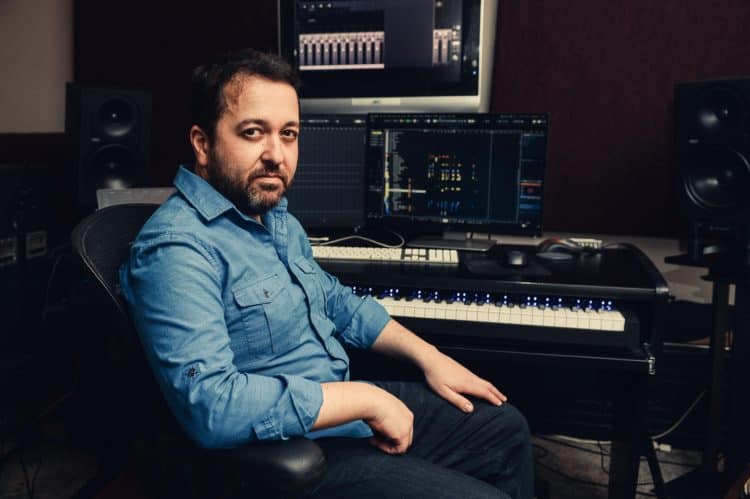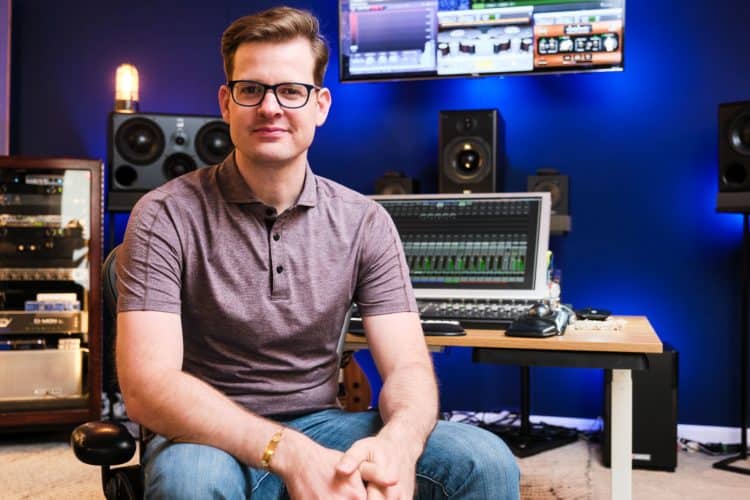
What are the best strategy video games for PC? Some might say StarCraft II, XCOM 2 or Endless Legend. If you like this genre of video games then you might want to check out Grab Games‘ latest release, Amoeba Battle. The official description: How does one amoeba defeat one thousand? Take control of a sole surviving amoeba and guide it in doing what amoebas do best – Feed to gain strength, Multiply to gain numbers, and Evolve to gain power. Turn your single-celled survivor into an amoeba army and take back the microscopic world! In order to get an inside glimpse at the musical aspect of Amoeba Battle, we spoke to the game’s composers Kenny Wood and Igor Nemirovsky. Below they talk about their hybrid orchestral approach to scoring the new strategy game.
-For people that aren’t familiar with Amoeba Battle, can you give a couple sentence rundown?
Kenny: Amoeba Battle is an RTS game where you can grow an army of amoebas with unique abilities and navigate your way through a gauntlet of brawls and fun challenges in campaign mode or cross-platform battle against your friends online and see who is the best amoeba general of them all!
-How did you get connected to or approached with composing Amoeba Battle?
Igor: I actually met the developers a while back while attending a USC grad program in film music. There was a game audio component to the program and we met through that and hit it off. We started work on their first game, Divergent Shift, and Kenny joined us shortly after. When they started work on their follow up game, Amoeba Battle, we were happily asked back.
-What instruments did you all find were key with this game to set the tone or musical theme you were striving to achieve?
Kenny: Choosing instruments was a blast on this game because it was a completely new set of worlds unlike anything I had seen in games before. At the base of it all, is the orchestra, but it’s adorned with sounds from around the world including dulcimers, tabla, synthesizers, hip hop drum machines, marching drum line, propane tanks, and the list goes on. The fun (and sometimes tricky) part was melding all these distinct colors into something fresh and new, rather than have them point directly at the regions they originate from.
Igor: Kenny primarily worked on the Battle Mode music, and I worked on the single-player campaign, which was broken up into four worlds. For each I imagined a different sound. The initial stages take place in the Mushroom Kingdom, and I pictured a lush, serene environment. So, I utilized orchestral timbres to create a sense of quick movement and contrasting color. For the Primordial Sea I worked more with synth textures and rhythms, high-frequency percussion, and low strings to create a feeling of current and movement. The Firelands would be a place of turbulence and danger, so my first thoughts were brass, heavy percussion, low strings, and again synth. And finally, for the Obsidian Peak we wanted a big, boss-battle feel so I sort of threw everything in to help the player feel a sense of urgency and finality.

-A technical question, when a game is on different platforms such as Steam or PS4, does the score have to be modified at all to go on those different places?
Kenny: In the case of Amoeba Battle, no, all the audio was cross-platform compatible and much of that credit goes to the head engineer, Aadarsh Patel, who is an incredible programmer. He’s so adept at this stuff, he even opened up the Unity engine code like an auto mechanic and made improvements on how it handles audio. This would be almost like hacking into Facebook and changing the trim color to green instead of blue just because you felt like it. He’s immensely gifted.
-Were you given freedom to choose the sound of Amoeba Battle or were you under specific parameters to work within from the developers?
Igor: We were given a lot of freedom. We’d already worked on their previous game and the developer team really trusted us, both for the score and sound fx. We would come up with a variety of ideas, send them out, get feedback, and revise. But ultimately it felt very much carte blanche in terms of style and approach.
-There are many different subgenres of video games. Amoeba Battle is a strategy game. Is there a specific general framework, music wise, that is applied to strategy games?
Kenny: Some of us look at Amoeba Battle as a “gateway” RTS, meaning it’s got a majority of the things that a hardcore RTS gamer would want, but it’s also a great 1st RTS for those who are new to the genre. In my mind, pacing is important for RTS because you’re not necessarily throwing all the punches in a chaotic flurry–instead you’re thinking strategically how to replicate, evolve, and position your amoebas to complete the missions. Having said that though, finding the right musical framework to us was more about hearing what we created alongside the gameplay and determining whether it “feels” right, as opposed to trying to emulate other RTS titles. Overall, the music is intended to spark wonder at new discoveries, inject drama at the intense parts, and be fun and thought/strategy provoking when it needs to.
Igor: I think it’s important to simultaneously drive the player forward and stay out of the way in an RTS. The player is making strategic decisions, so you don’t really want to distract from that. At the same time, you’re trying to create a feeling of immersion into the story and setting, and music is a big part of that experience.
-A game’s sound design and score are often woven together pretty closely. How close did you work with the sound designers of the game?
Kenny: We are the sound designers! And we took a sort of yin-yang approach to Amoeba Battle. Igor started with music and I started with sound, then gradually we switched so by the end of the development, I was working on music while Igor was finishing up the sound. This allowed the sonic universe to grow and evolve together really organically and we had synergy between all the audio assets right away through the entire process. It’s a pretty cool thing when everything is working together and you know whatever has yet to be created will find its place within the landscape very quickly.
-You both also scored the video game Divergent Shift almost 10 years ago. Technology wise, how different was it scoring this game? Meaning were there any new programs you used that weren’t around back then?
Kenny: The workflow was pretty similar because we were working with the same clients and that process being already-in-place is always helpful when delivering a lot of assets. In the past 10 years though, a lot has changed for music production. We have computers that can handle so much more with new synthesizer and virtual instrument technology, but more than that, we both benefited from a decade of our own self-development. Our ears are more finely tuned and we are 10 years further along with our compositional styles and techniques. The result (at least for me) is a tighter, more polished, more deliberate and dynamic experience when the music plays.
Igor: I don’t think the technology has substantively changed a lot. Things have just gotten faster, bigger, and easier to use. If you divide the composer’s toolbox into two piles, you end up with one pile containing a set of knowledge, experience, and an understanding of music theory, of story-telling, and of the ways in which one can communicate. And the other tool box is filled with the technology and the technical know how. That second toolbox has changed, admittedly, and it’s still changing rapidly. We’re on the cusp of MIDI 2.0, which will probably be a game changer in years to come. But ultimately a DAW is still a DAW. And samples are still samples. And notation is still notation. And recording is still recording. And it’s up to the composer to work with what they have so that they can communicate clearly and let their unique voices be heard.
-You have scored other mediums besides games. How does creating a game score differ from creating a film score?
Kenny: To me, the most noticeable difference is that in linear media (film/TV) you must frequently bend, break, or otherwise prepare the music to fit in awkward spaces because the events on screen are locked in their timing and not always friendly to musical flow. That is so much of the problem solving one has to do and only the best composers can write fluidly through those quagmires and make them sound effortless. Contrarily in games, since the player decides the timing of almost everything, it’s much less of a burden on the composer and he/she can simply write the music and give it its own space to live, which is often very liberating. Depending on the project, game music can also take on a life of its own, reacting and evolving to what’s happening in the game, which means a composition may have to be broken into layers or segments that swell in or get triggered when a game event occurs. This is probably the most challenging thing to plan for a composer, but it is amazingly fun especially if you geek out about it like me. The possibilities are endless.
Igor: They’re two very different animals, with their own challenges and rewards. Film music is a temporal beast, entirely married to the experience of the moment. Something happens on screen, you hit that moment. Or you don’t. Regardless, your musical decisions help communicate a story to the audience, and it’s entirely moment-driven. Because of this film music can help lend itself to create subtext in ways that game music might not so easily do. A game’s story often progresses at the player’s pace. So the music then becomes more about atmosphere and experience-building, and less about granular subtext. Both lend themselves to the process of immersion and storytelling, but they’re done so in different ways. When you’re writing a game score, if it’s background, in-game music you’re constantly aware, throughout the composition process, that a.) you need to feel consistent and steady, b) you need to stay out of the way, and c.) you need to loop back around from the ending to the beginning and do so in a seamless way. Then there are layering processes that are often utilized for varying intensities and game states. And finally, you have to be aware of the fact that through all of this the player will also be hearing sound fx, audio jingles (which may, themselves be musical) and transitional moments. So, you’re constantly thinking of key, tempo, instrumentation, dynamics, and blend.
This doesn’t happen in film, which in some ways is freeing; but it’s also limiting. In film you’re reacting, in the moment (and in a musical way), to events on screen which may not be musically timed. You’re having to bend the musical language and will it to communicate to the audience just when it’s needed. And as you’re writing you know precisely what the audience is experiencing apart from the music. You can see it, hear it, and feel it in the performances, camera movements, and foley work. This lends itself to a very different creative process. Both mediums are immensely rewarding to work in. And both present their own challenges to be puzzled out.
 Follow Us
Follow Us





